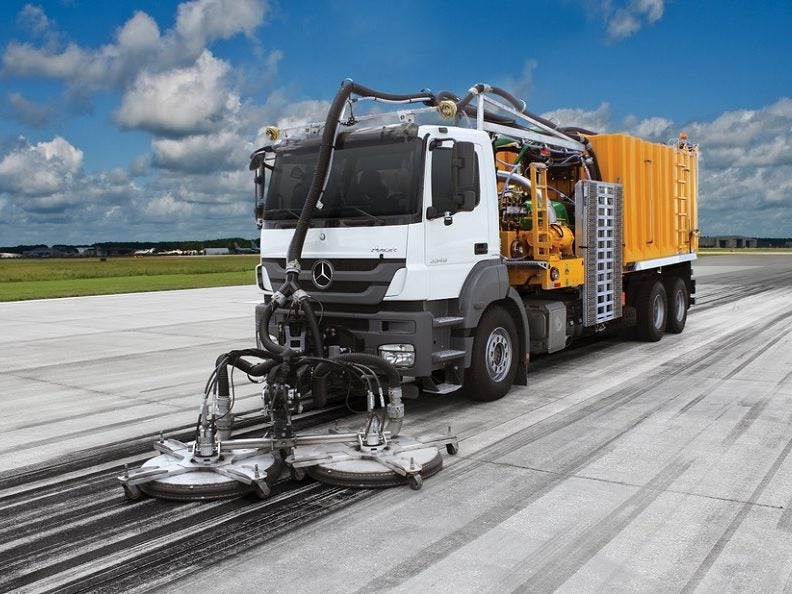
Pittsburgh International Airport’s assistant superintendent of airfield maintenance Jim Moorhead spoke about using Hog Technologies‘ Stripe Hog at the airport.
What motivated Pittsburgh International Airport to purchase the Stripe?
Jim Moorhead: The FAA is constantly changing requirements for airfield markings for improved runway safety. The FAA Advisory Circular 150/5340-1K dated 2010 again changed requirements on airports. The past requirements were to place Surface Painted Holding Position Signs (SPHPS – Red Blocks) on every holdline on the airfield. The FAA gave the airports the option to use a 9ft or 12ft stencils.
We decided to use the 9ft stencil due to all of our taxiways could not accommodate the 12ft stencil (taxiway size). However, in 2010 the FAA changed the requirement stating all SPHPS must be 12ft in size by 2012.
We had to change over 140 surface painted holding position signs to the 12ft requirement. All work was accomplished last summer and the markings were repainted in-house without the use of a contractor or an engineering firm. The Stripe Hog gives you the ability to be more aggressive and take on these challenges without outsourcing the work.
What are the most significant values of having a Stripe Hog in-house?
An important quality the Stripe Hog gives to airports is the environmental aspect. Airports typically emit high amounts of pollutants, it’s just to the nature of the business. If you can reduce that rate in any way, it helps. Airports are heavily regulated by the federal government, from the FAA, EPA and others.
In the past, to remove the contaminates (rubber at the touchdown area of the runway) we used a product to agitate the rubber contaminate and then broom off the residual waste.
Two aspects were improved by the Stripe Hog, First, the contaminated water from runoff is eliminated and eliminating the use of a chemical to agitate the contaminant. Also, when we used the chemical it never gave use the friction number (MU) expected from a clean runway. When we used the Stripe Hog (demo) it sent our friction numbers to the level required by FAA Advisory Circular 150/5320-12C in a timely manner.
In order to remove rubber contaminate, the runway is required to be closed at our facility, which impacts the users (airlines, military, general aviation), the Stripe Hog has always achieved the highest quality with minimal impact (efficiency), which relates to safety and customer service for airport users.
How has water blasting served you with airfield markings?
Paint build-up is another important point for us. We demoed other machines such as shot blasters, grinders and another water blasting machine and none were able to achieve the quality and speed of the Stripe Hog.
Since the unit recovers the foreign object debris (FOD) such as paint chips and pieces of loose aggregate, it improves the safety of the airfield and environment during maintenance. Without a doubt, that is one of the most important qualities it can offer to an airport. FOD causes millions of dollars of damage to aircraft parts and engines yearly, again another great quality of the Stripe Hog.
How much has the Stripe Hog changed your business at Pittsburgh International?
In reference to the FAA inspection process, only commercial serving airports are inspected by the FAA (GA airports are inspected by their state). The number of commercial airports that achieve 100% on their annual FAA 139 inspection are very few.
Numerous things are inspected from markings, signage, lighting, obstructions, fueling, records of inspections, training and the airport certification manual. The most criticised parts of the FAA 139 Inspection are the markings, signage and lighting, which are usually contributing factors in an aircraft incident.
Since taking ownership of our Stripe Hog in 2008, our FAA Part 139 inspection (regarding paint) has improved greatly with numerous years without a discrepancy noted on our markings. Past discrepancies referencing paint markings would be obscured markings on the runway from rubber build up, paint flaking or chipping, reflectability in our paint (glass beads), as well as general mistakes by paint crew without the ability to totally obliterate or eradicate the marking that was painted incorrectly.
Also, on any commercial airfield, you are not permitted to paint over another marking with a different colour, such as white paint over yellow paint (FAA AC 150/5340-1K). If you have to change a painting scheme (ramp, taxiway, runway marking), the Stripe Hog again gives you the ability to make the changes in-house and move quickly.
Of course, safety is a top priority at any airport. How has safety been at Pittsburgh International with the Stripe Hog?
Safety is important. In fact, it is the most important value the Stripe Hog offers. Airport personnel are heavily trained on the requirements of operating on an airfield.
When an airport acquires a Stripe Hog and completes the work in-house, the safety of the airfield is not compromised. When a contractor has to complete work on the airfield, airport personnel or a construction manager have to escort and oversee the contractor during the work, which still doesn’t guarantee safety or prevent an incident on the airfield. With the use of airport personnel and their training of operating on an airfield, the highest quality of safety is achieved.
The requirements are so high for runway safety, one mistake can have huge impacts. Most airports realize this and attempt to complete paint removal, rubber removal and painting in-house to minimize cost and achieve the highest level of runway safety.
We understand you gave your Stripe Hog a nickname?
We did! The Magic Eraser.


